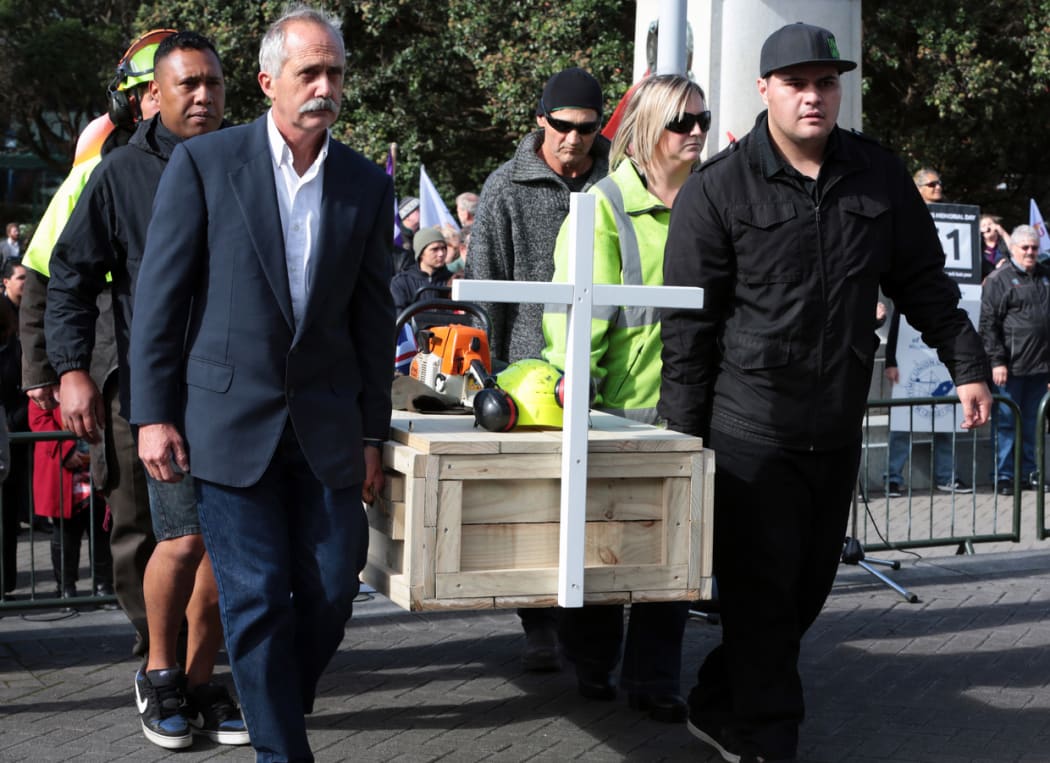Early findings from the Independent Forestry Safety Review say it is clear there needs to be widespread change to stop injuries and save lives.
The Independent Forestry Safety Review panel was set up in February this year and has spent three months gathering information, including talking to families of some of the workers killed.

Families and colleagues of forestry workers killed at work protest at Parliament. Photo: RNZ / Diego Opatowski
The panel said challenging and often harsh conditions are contributing to the rate of serious injuries and deaths. Over five years from 2008 to 2013, there have been 28 deaths and 967 serious injuries.
The panel points out that this is one death short of the Pike River mine death toll, and the injury rate in forestry is almost six times that of other sectors.
It says there needs to be widespread change as the number of forestry injuries is disproportionate and unacceptable.
Panel chair George Adams told Radio New Zealand's Checkpoint programme on Friday that current guidelines need to be replaced with mandatory standards.
"Take training, for example. Today there are some recommendations around training, but there is no mandatory training.
"You can't be a gasfitter these days, you can't be a forklift driver without mandatory training. But you can operate in the most dangerous environment from a working prospective in the country."
Mr Adams said this must change.
Labour Minister Simon Bridges said the death and injury rate in the forestry industry has been too high for too long and the sector needs to own the problem.
"There's real problems there, and it's very important that forestry industries here show some ownership to achieve an enduring safety solution. The Government's got to be part of this - but we can't do it alone."
The First Union represents some workers and believes the final findings will have as much significance for forestry as reports into the Pike River disaster had on coal mining.
Thousands employed by sector
More than 4000 people work in the forestry sector, which is New Zealand's third-biggest export earner and brings in almost $4 billion a year.
The review panel's chairman George Adams said it backs other findings that there is a laid-back complacency about safety from the boardroom to shop floor.
"I think the public are much less tolerant of taking the sort of risk that kills 10 people in a year, and I think that's one of the reasons why the industry has actually got to the point where it's finally figured out it needs to do something, which is why this review has happened."
Panel member Mike Cosman said the industry suffered from a culture where productivity was seen as more important than worker safety.
During its information-gathering the panel heard stories of workers not having employment agreements and being expected to buy their own protective clothing, he said.
Increasing the perceived value of the sector would also help; Canadian lumberjacks were seen as skilled professionals who worked in a difficult industry but that was not the case in New Zealand, Mr Cosman said.
This led to poor pay, a lack of investment in skills and training, and workers and crew bosses being more likely to compromise safety to get the job done valuing productivity over safety.
"You wouldn't expect a gas fitter to say, 'Oh well, I'm not going to bother to solder this joint properly because I've got to get the job finished'. They would say, 'No, my profession requires me to do a decent job and to do it to professional standards and if I don't I will be accountable.'"
The panel members will next week set off on a six-centre tour of forestry regions, where they will talk to workers, industry members and the community at a series of public and private meetings.
The panel is also launching an anonymous online survey which asks about such things as the number of breaks workers get and about working in bad weather.
However, it said no single recommendation will lead to the change that's needed, and that there needs to be a number of co-ordinated changes.
Last year, almost half of the 164 forestry operators visited by inspectors were found not to be meeting their health and safety obligations.
The review's findings
- Widespread change must occur in all parts of the sector in order to prevent injuries and save lives.
- The injury rate for the sector is "disproportionate" and "unacceptable".
- The panel wants to see employment agreements or contracts for all forestry workers providing sufficient security and clarity for all parties on working conditions.
- The panel is not satisfied there is a clear system to verify the safety of new and existing machinery and other technology before it is used.
- Regulatory oversight has not kept pace with developments in industry ownership and organisation.
- Any absence of accidents in forestry blocks does not necessarily equate to a good safety culture and practice.
- Recent coroners' reports highlight some crew bosses do not appear to speak up and stop hazardous work immediately when they see dangerous practices taking place.
- The quality and adequacy of forestry roads, bridges and skid sites are variable and sometimes inadequate.
- A number of co-ordinated changes must be made to ensure forestry workers arrive home safely each and every day.

